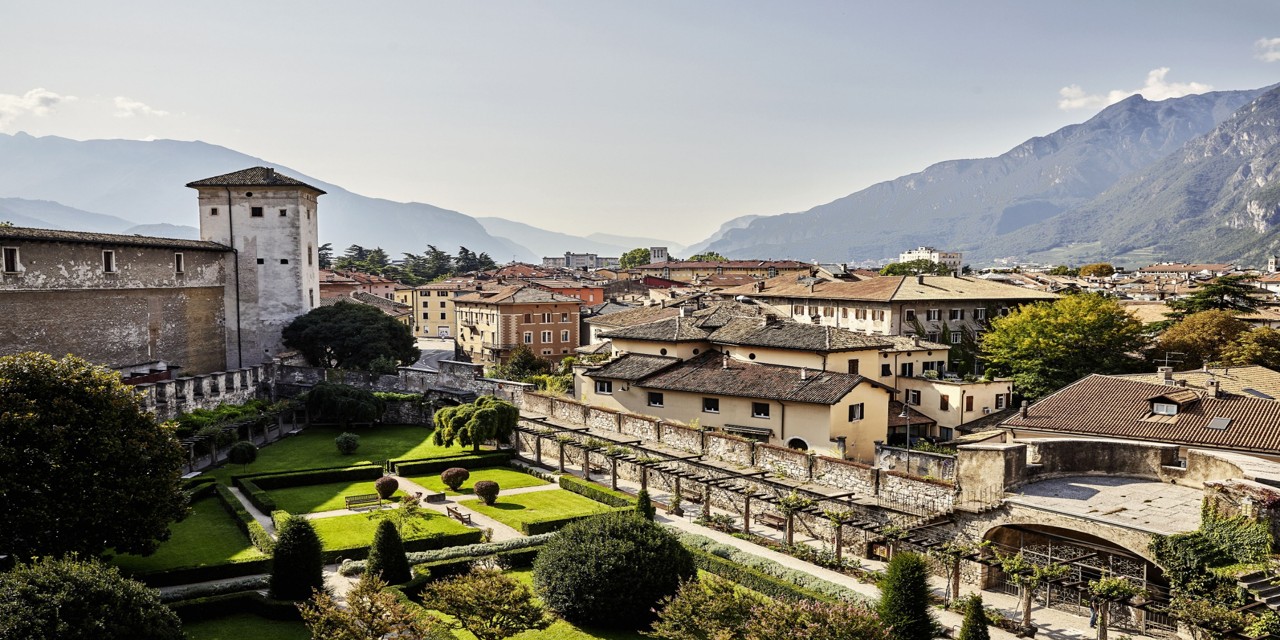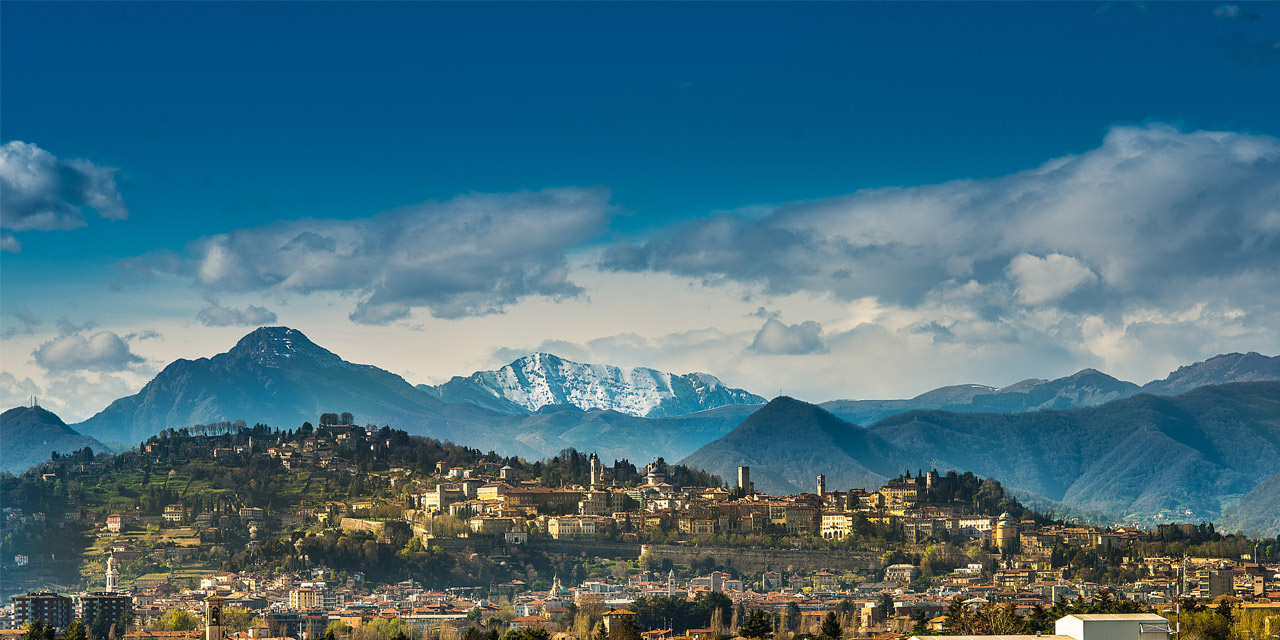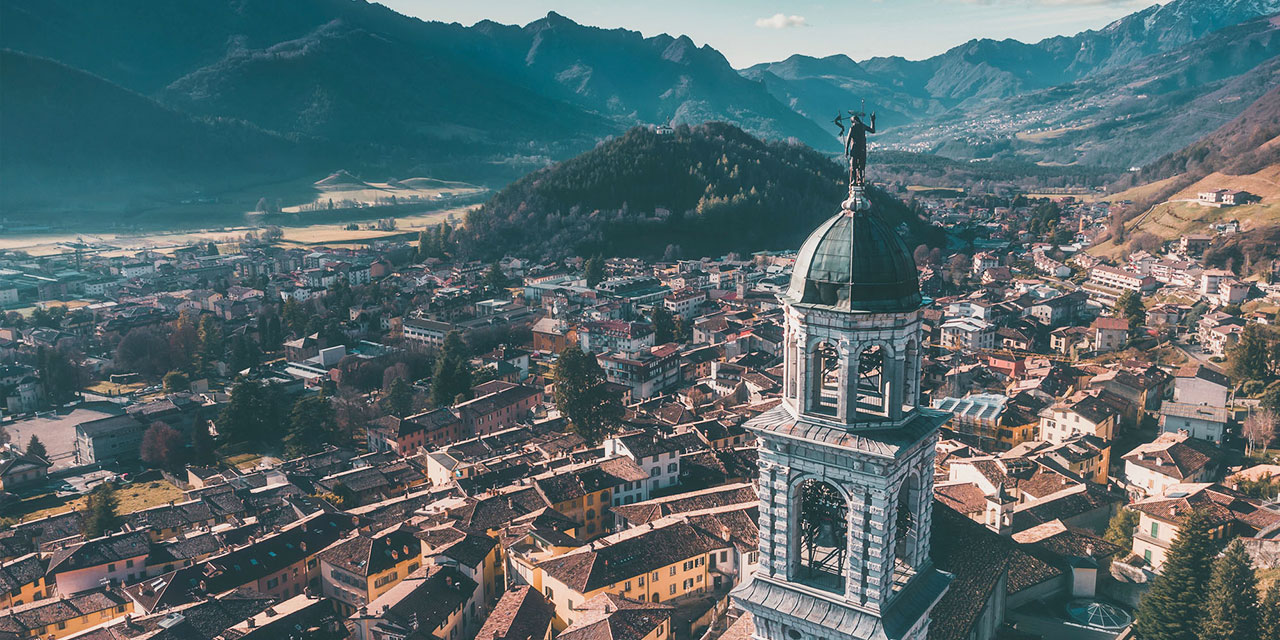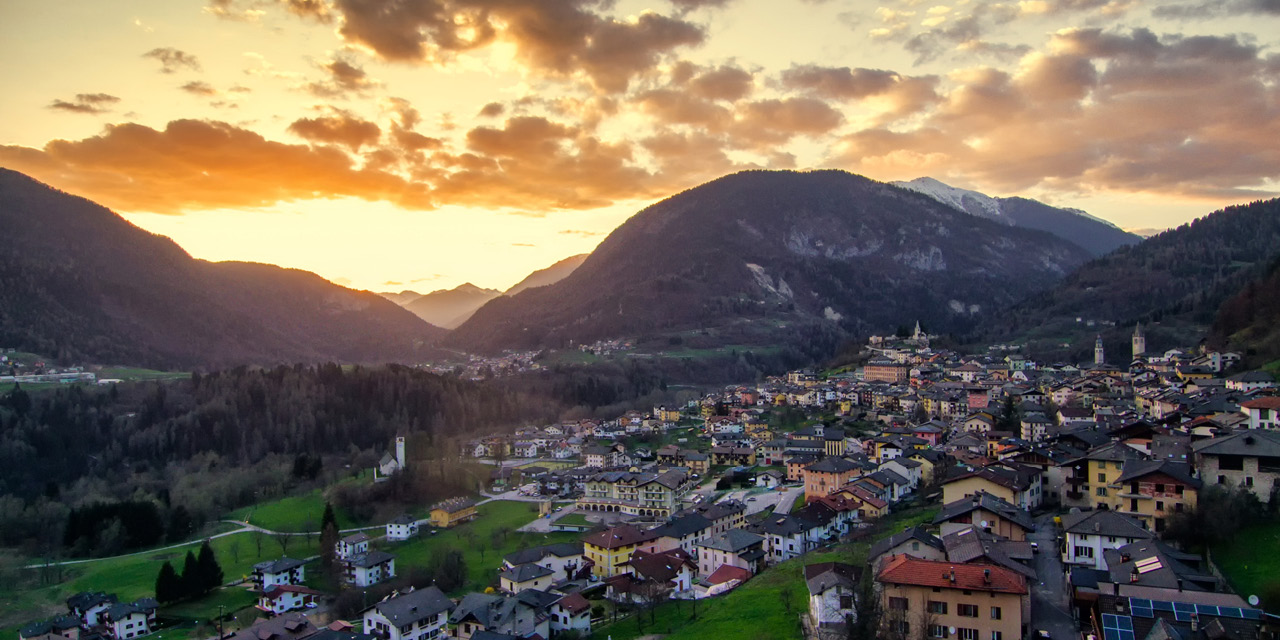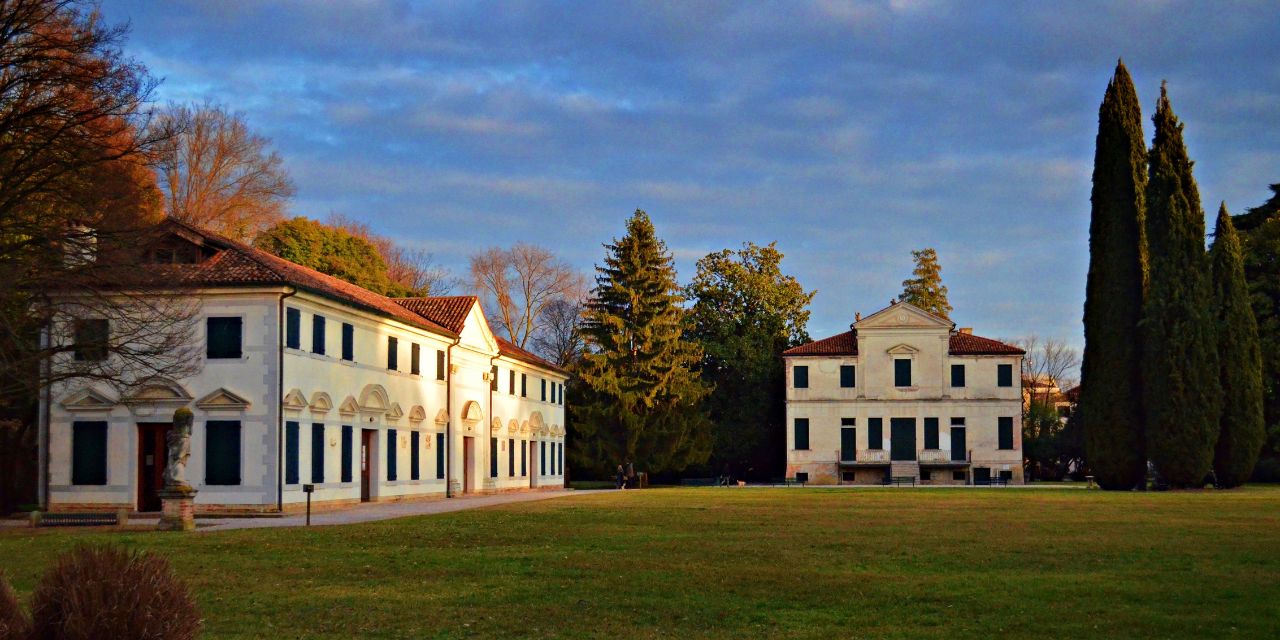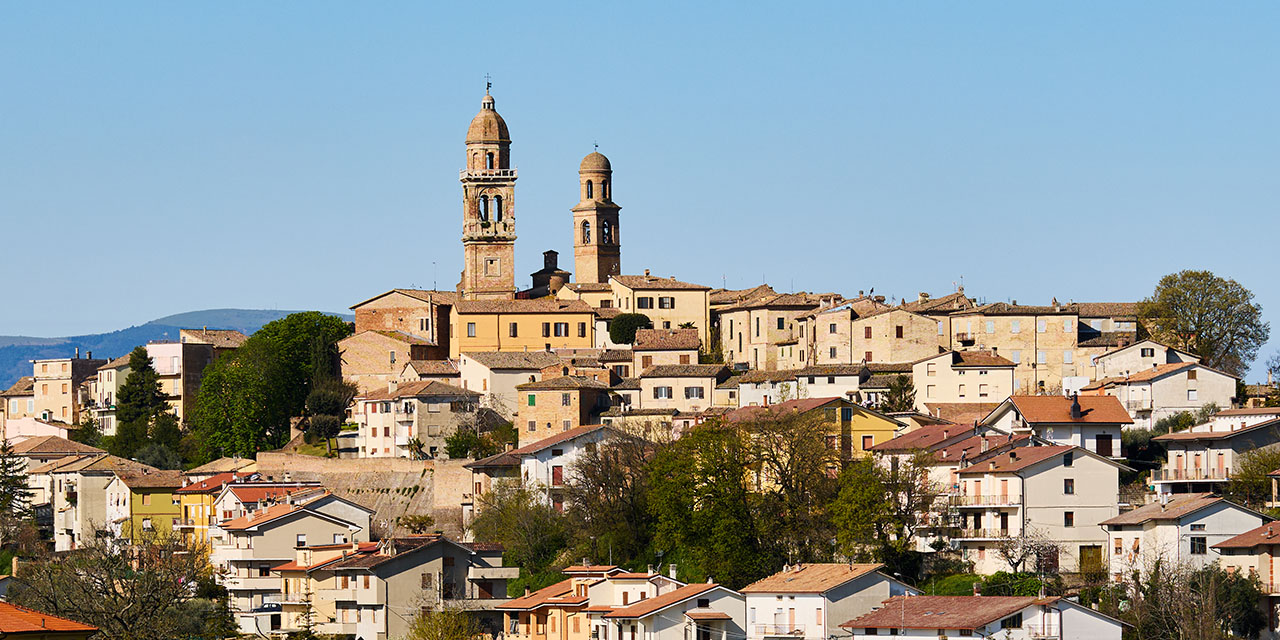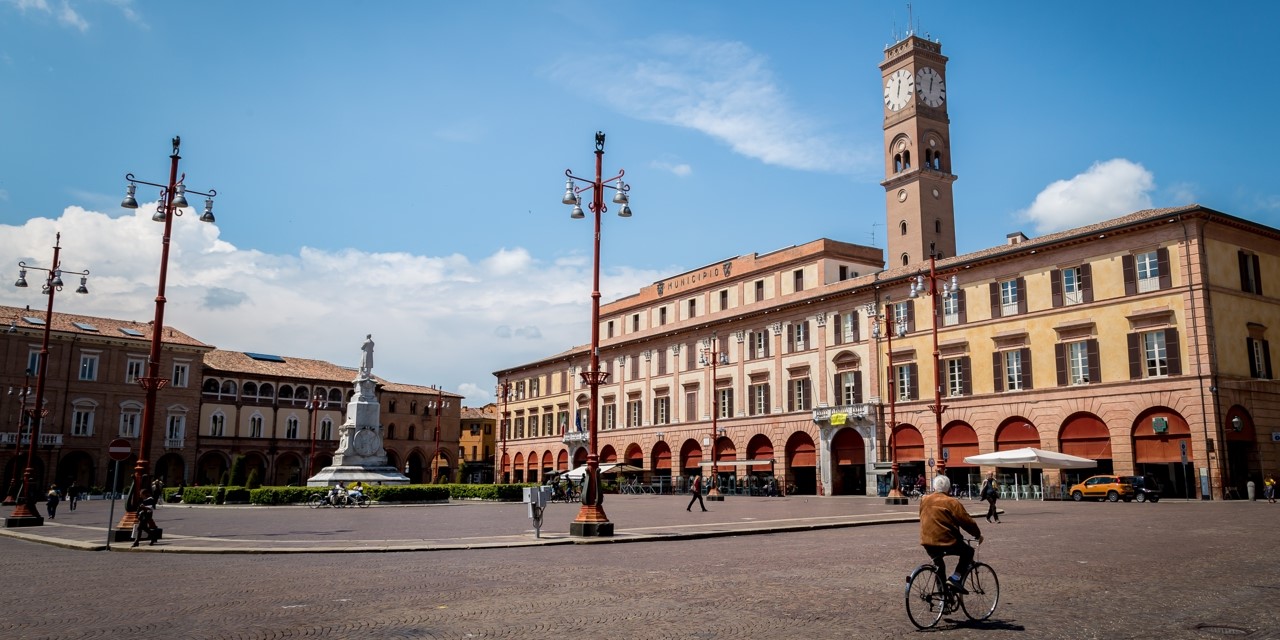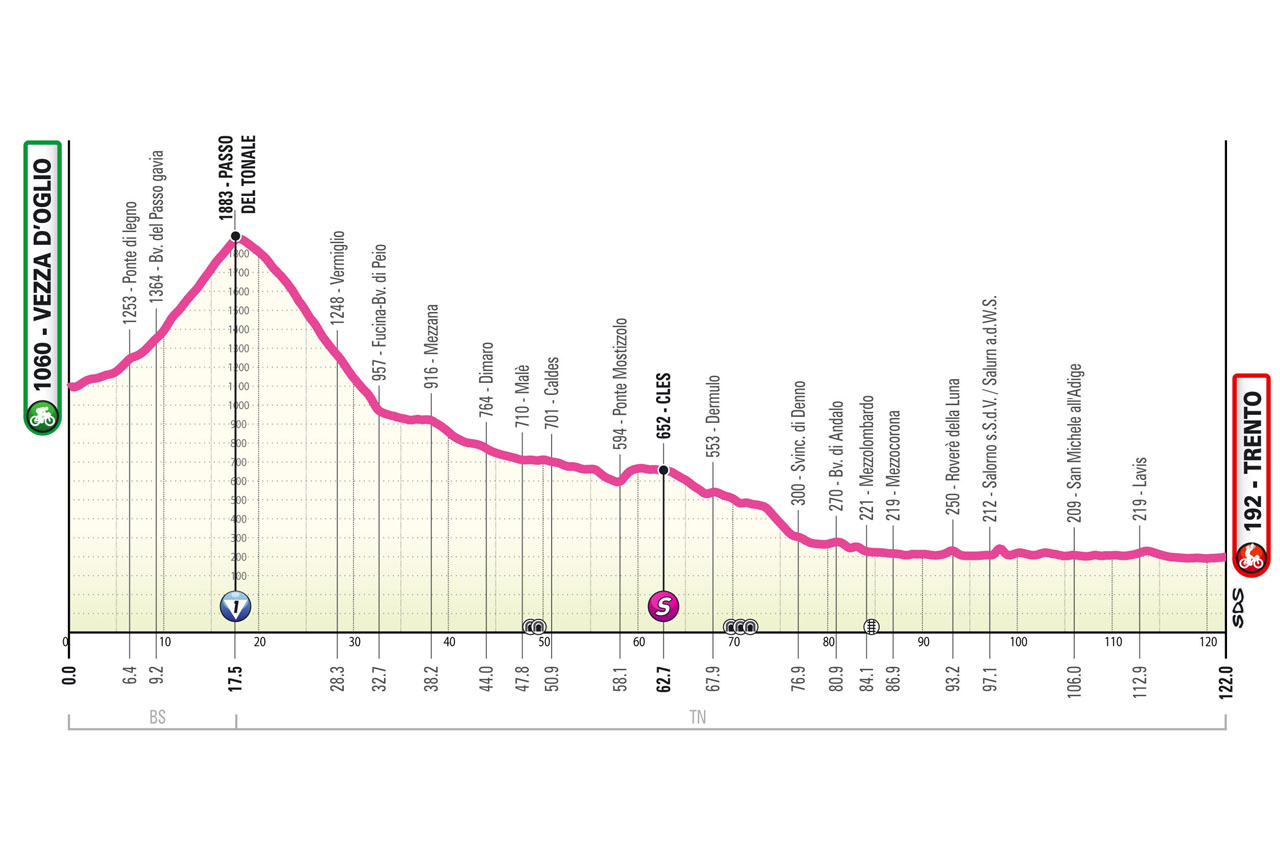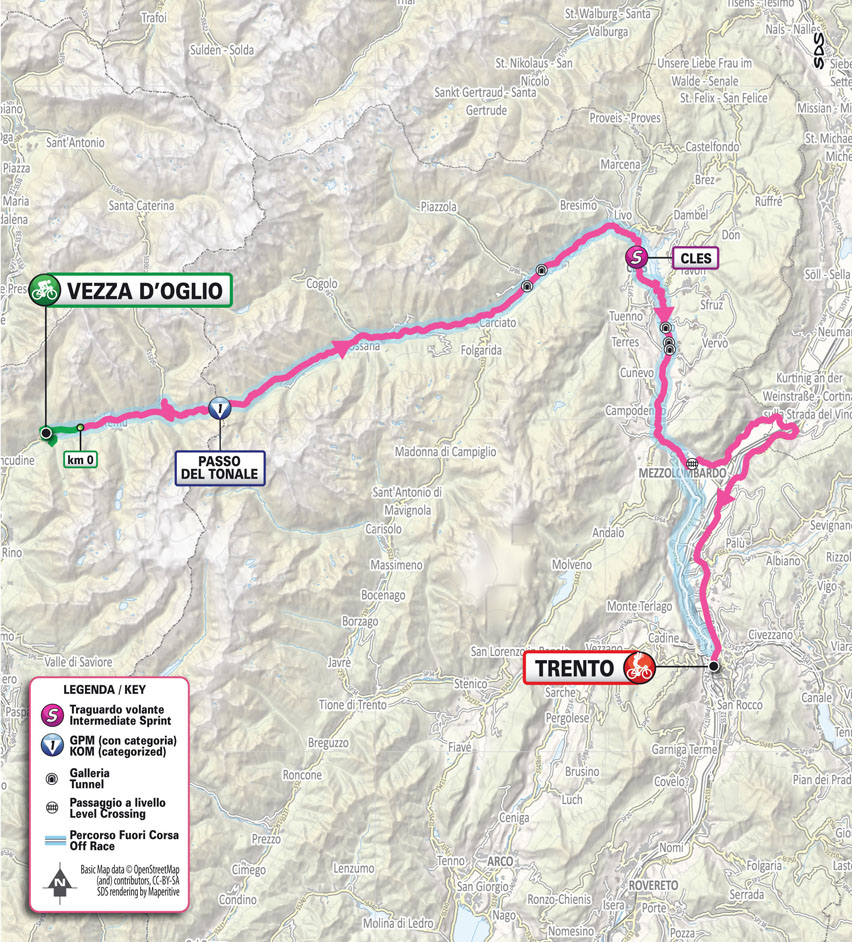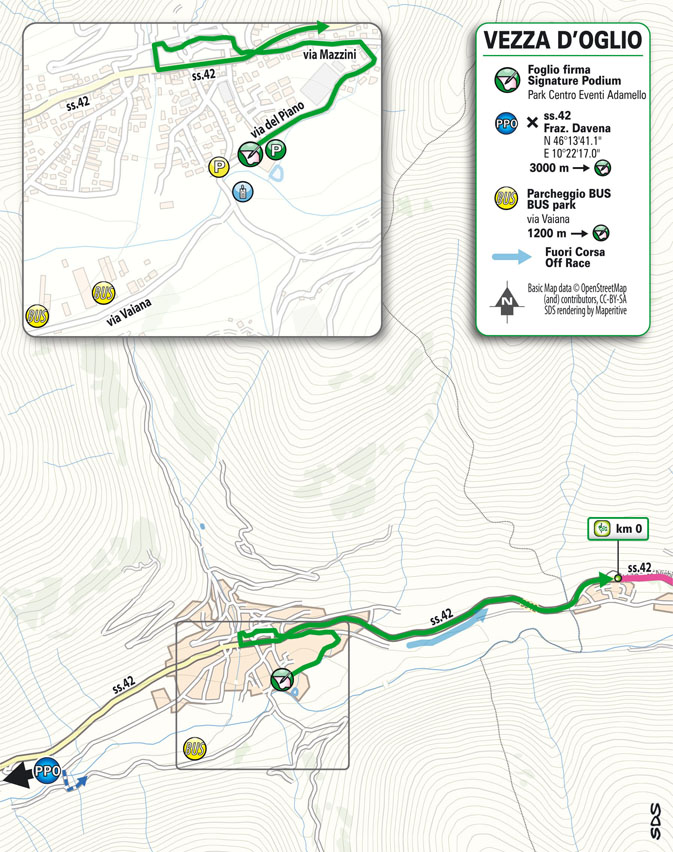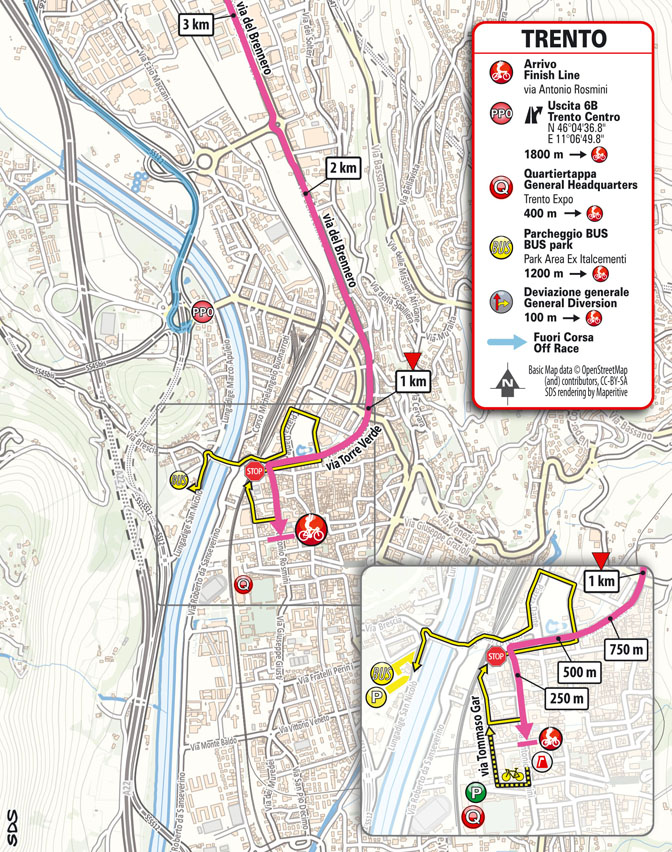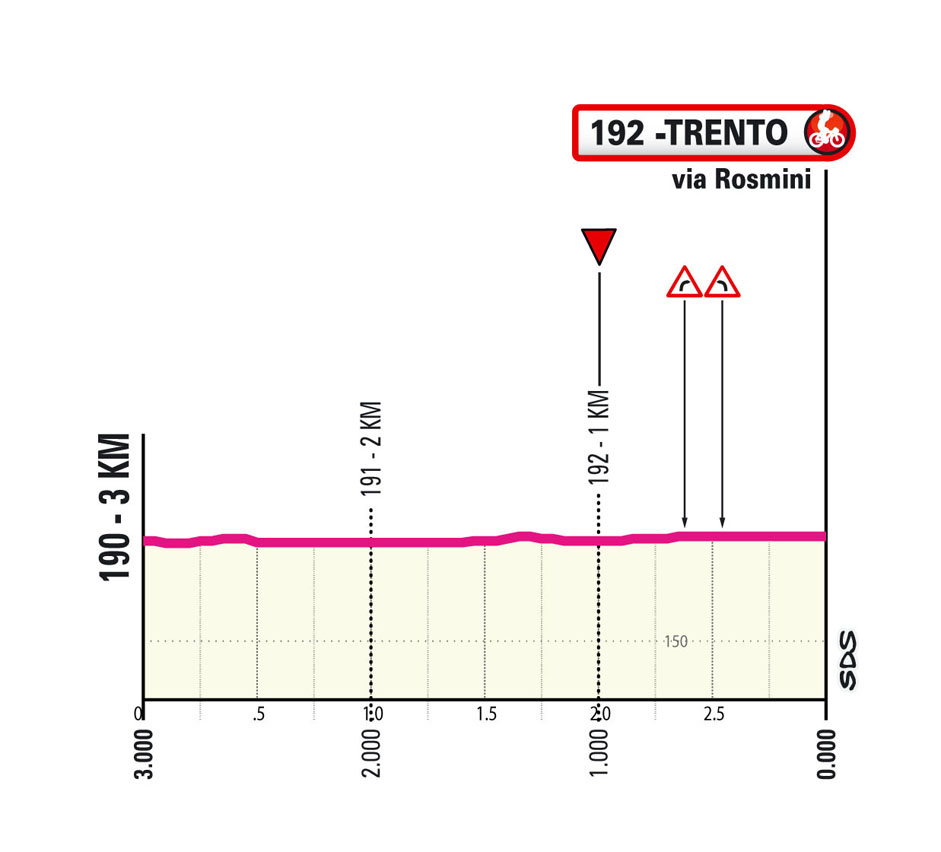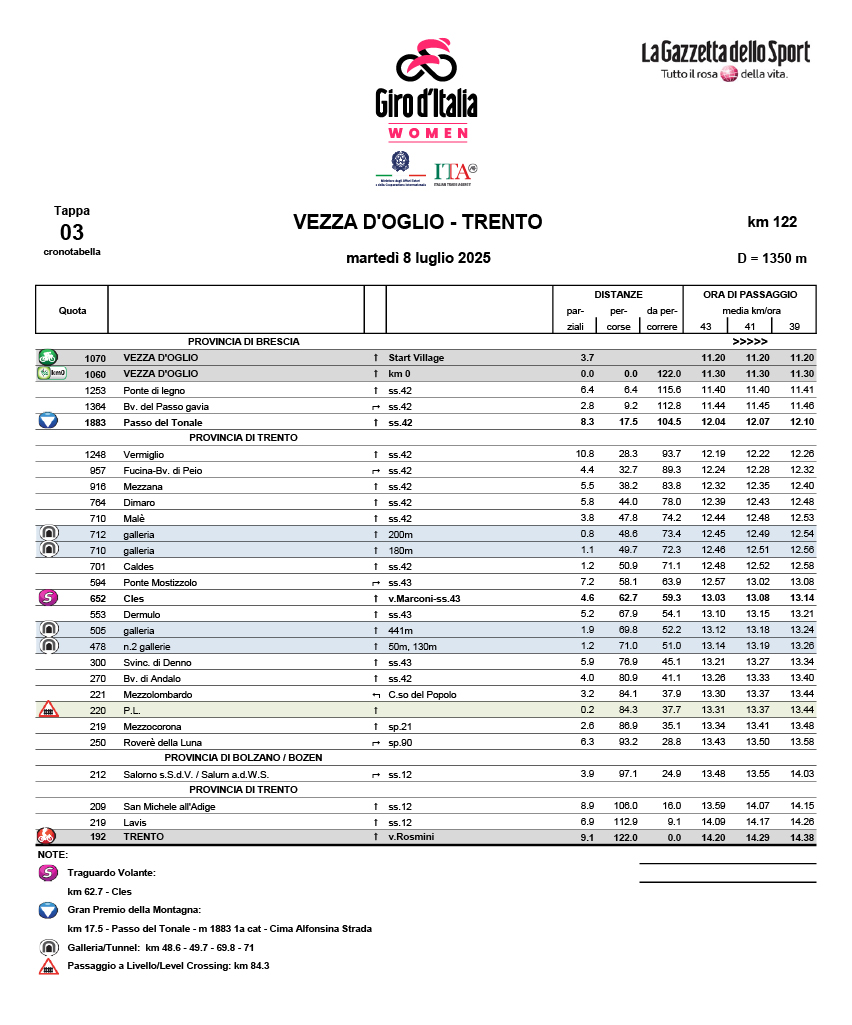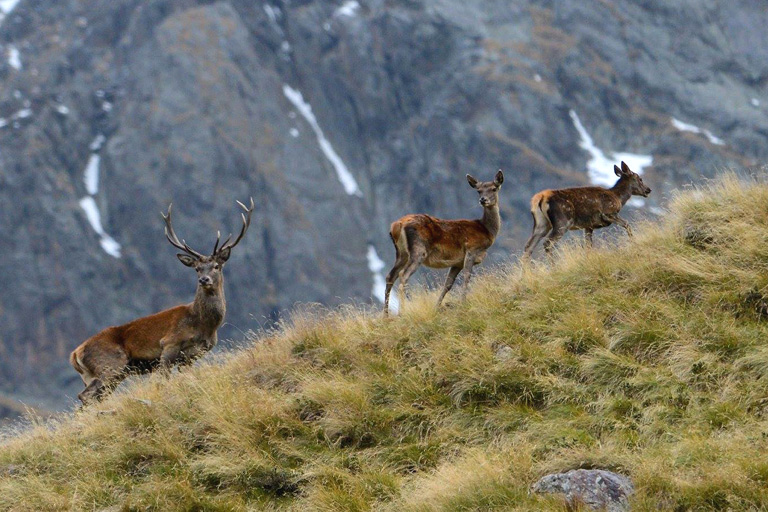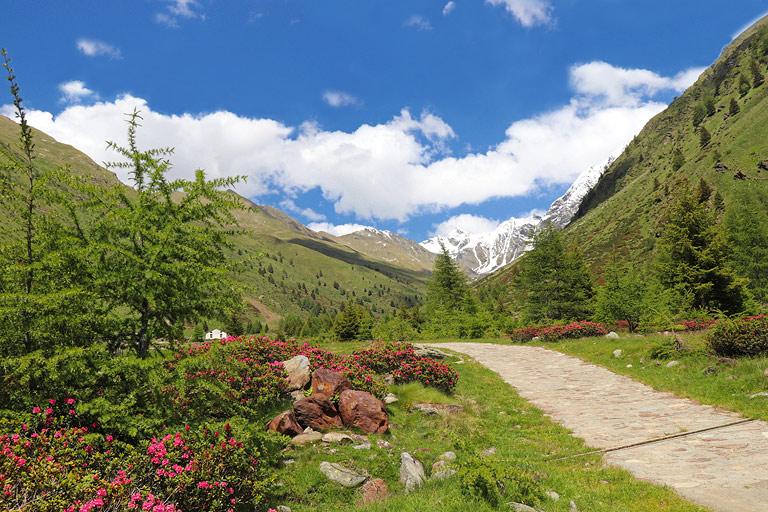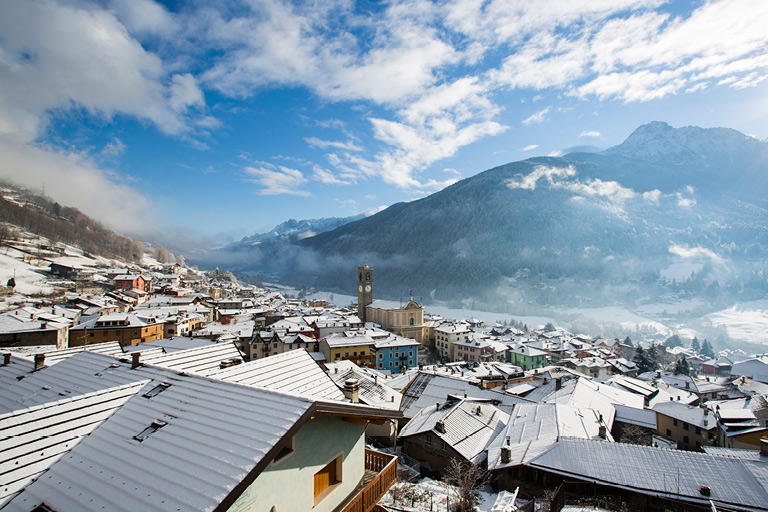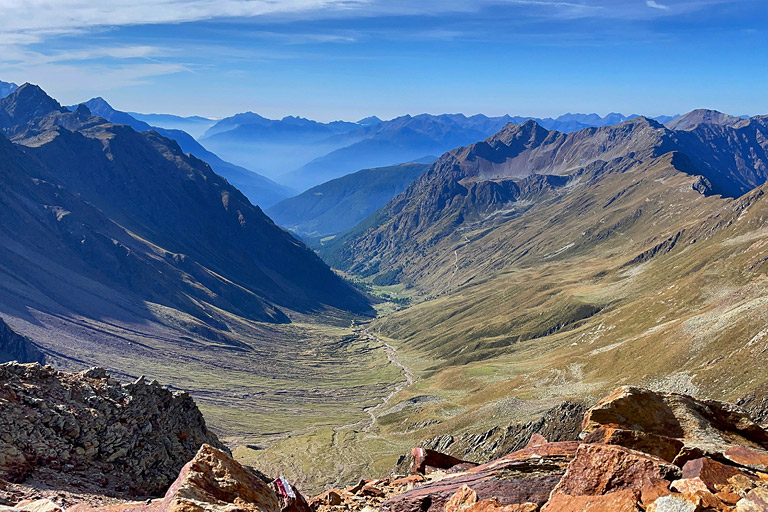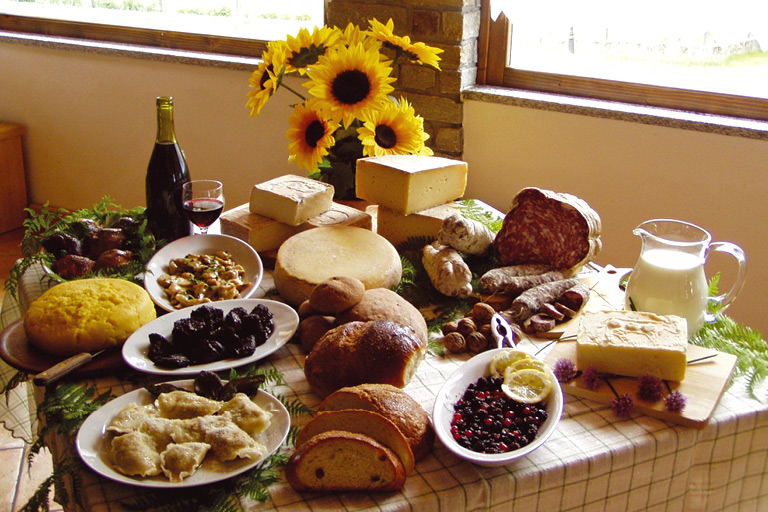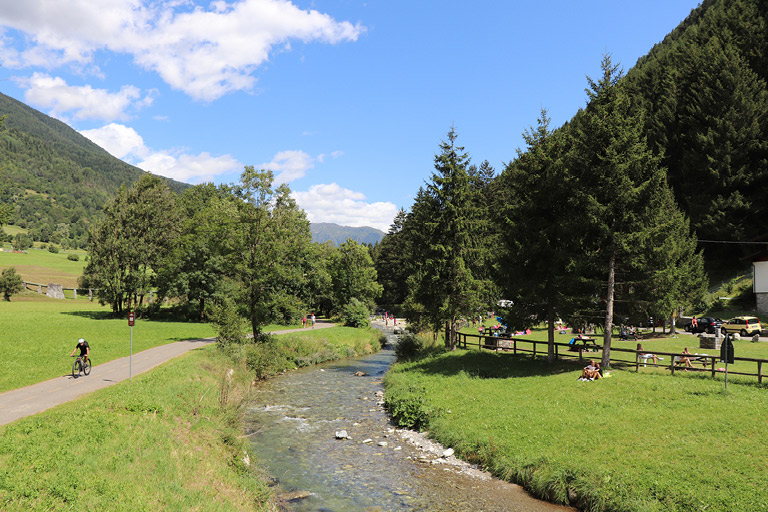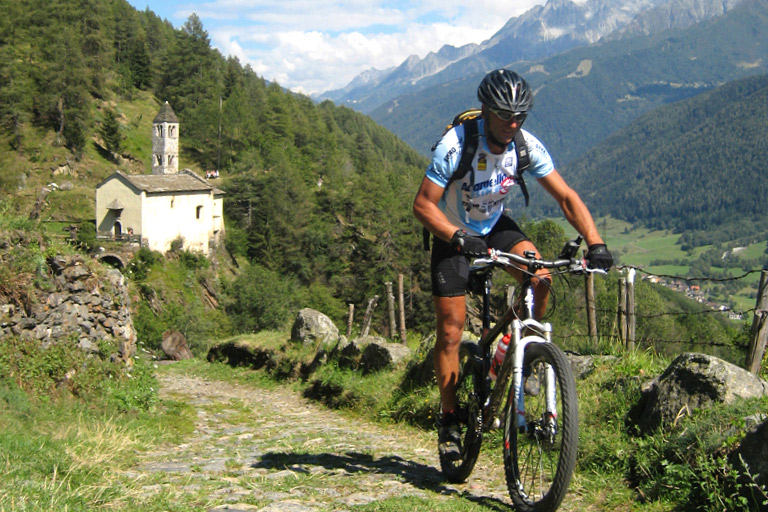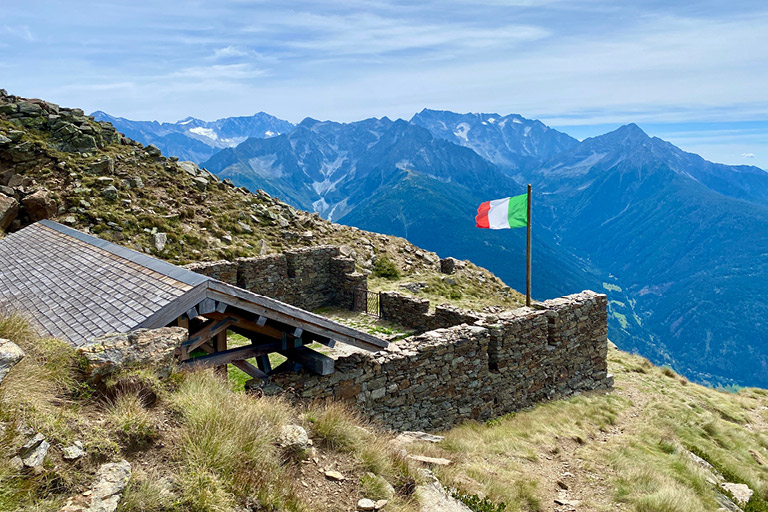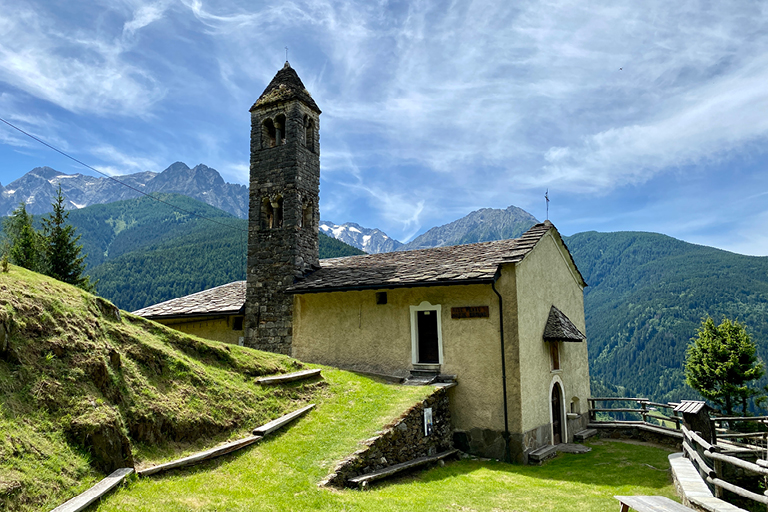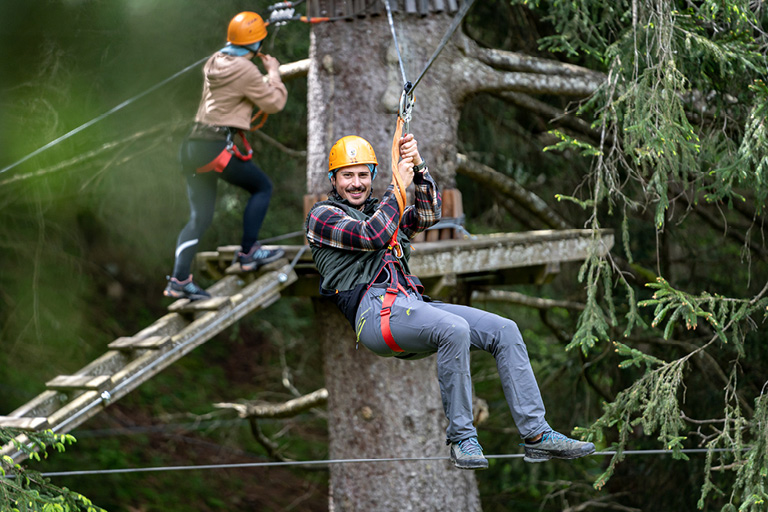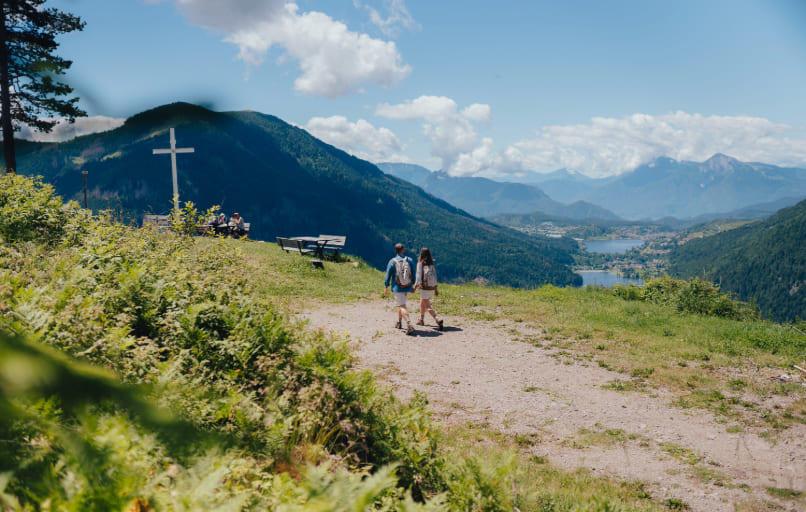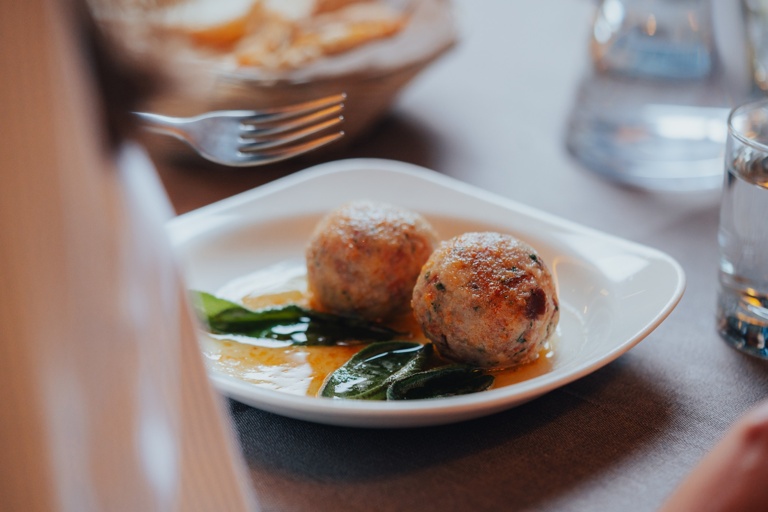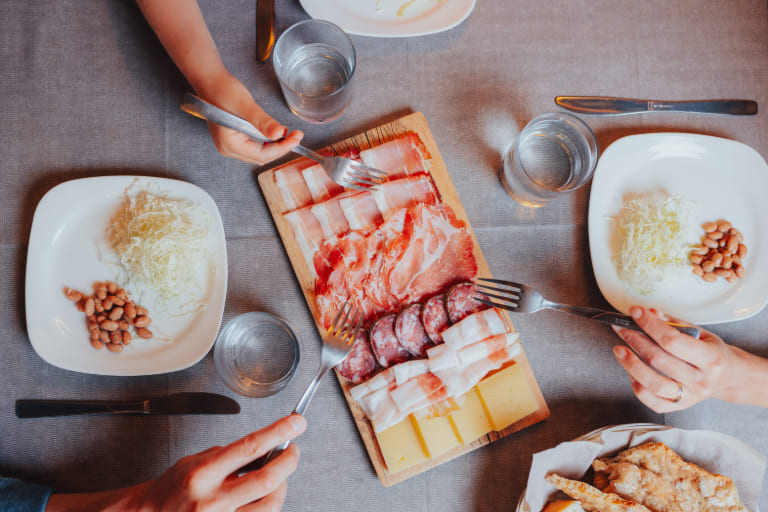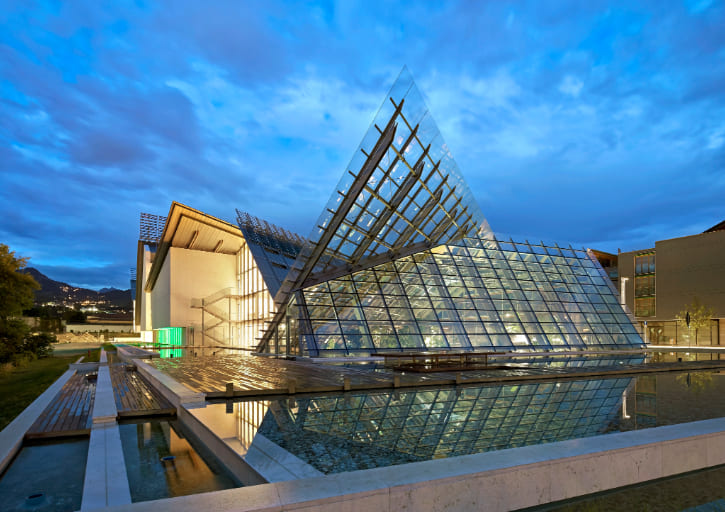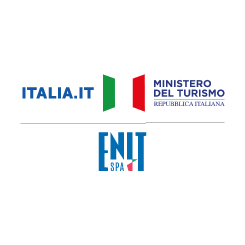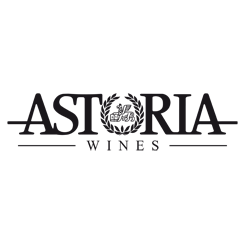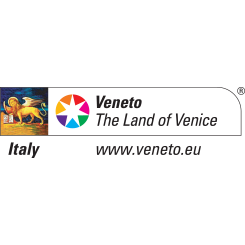learn more
technical info
profile
map
technical info
The Giro’s first opportunity for the fast wheels. The stage kicks off with the ascent of Passo del Tonale (Cima Alfonsina Strada), followed by a very long descent through Val di Sole and Val di Non. After Mezzolombardo, the terrain undulates slightly through vineyards before heading for the finish in Trento.
Final kilometers
Flat urban run-in with wide roads, roundabouts, and a few curves. Final straight: 350 m on asphalt.
start / finish
final kilometres
itinerary timetable
tourist info
Host city:
Vezza d'Oglio
Overview
Vezza d’Oglio is part of the alpine valley that the Camuni populated during the prehistoric age, the Camonica Valley. The valley was conquered by the Romans only in 16 B.C. under the Emperor Augustus; traces of their presence remain in the Vicinie of Grano and Tù.
In the 6th century the Lombards descended and in 774 Charlemagne’s troops. He donated many territories in the area to the monks of Tours; in fact, in this period lies precisely the foundation of the ancient Church of St. Martin.
From around 1300 began the epic of the Federici, a powerful family that, scattered throughout the Valley, also settled in Vezza; evidence of their presence is the ancient noble palace located next to the parish church, in which are visible the red sandstone portal with the noble coat of arms, and the ancient medieval tower. The Federici dominated the entire valley until the members of the family came into conflict. In more recent history during the period of the III War of Independence, we enter the battle of Vezza d’Oglio on July 4 1866 where, a regiment of Garibaldian volunteers united with one of bersaglieri, pitted themselves countered and asserted their valour over the Austrians; a memorial monument was erected in the town’s main square, named precisely “Fourth of July 1866” and an ossuary at the cemetery. Other battles that have seen the country as a protagonist have left the marks of ancient and more recent fortifications; those of the promontory known as “the Castellino” and those of the second line of advanced defence of World War I, at Cima Rovaia.
Vezza d’Oglio today is a pleasant tourist village in the Upper Camonica Valley located in a totally enviable position, set at the confluence of two side valleys that frame the town, Val Paghera in the Adamello Regional Park and Val Grande in the Stelvio National Park. It offers an enchanting and incomparable panorama capable of surprise.
In fact, at any time of the year it is possible to mix fun and entertainment with rest and tranquillity, regenerating body and mind in contact with a still uncontaminated nature. The proximity to the well-known village of Ponte di Legno, in addition to the unmissable Alpine passes of Tonale, Gavia, Mortirolo, Aprica and Stelvio, make the town a strategic starting point for a variety of trips and excursions.
Food
Vezza d’Oglio boasts a rich culinary tradition linked to the territory and its products. Among the typical dishes:
- Casonsei (Casoncelli): They are a signature dish of the local cuisine. It is a type of fresh egg pasta filled with a variety of ingredients and its recipe changes slightly depending on the area. In Val Camonica, the filling often includes sausage, meat, herbs, potatoes, leek and other ingredients. They are traditionally served with melted butter and grated cheese and sometimes bacon or sage are added to give them more flavour. Every year on November 11th, during the feast of Saint Martin, Vezza d’Oglio hosts the Casonselada, a popular event dedicated to tasting this delicious local speciality.
- Bossolà: This soft ring-shaped cake is a typical dessert of the Christmas holidays, although it is also enjoyed year-round. Its basic ingredients are flour, sugar, butter, eggs, baking powder and lemon zest. It is kneaded and baked in the shape of a donut. It is a dessert that is handed down from generation to generation.
- Spongada: This sweet focaccia is a traditional dessert from Camonica Valley, originally prepared for Epiphany and Easter, but now enjoyed throughout the year. It is made with simple ingredients such as flour, eggs, butter, and sugar. It is often baked in a wood-fired oven using the residual heat left after baking bread. Its surface is covered with sugar and sometimes whipped egg white or jam. It is often enjoyed with a slice of salami or other cured meats, an unusual pairing, but one that is widely appreciated.
- Cured meats and cheeses: Artisanal cured meat production has a long-standing tradition in Vezza d’Oglio. Several local butchers specialize in processing beef, pork and even game meat, producing both fresh and seasoned sausages such as pancetta, salami and soppressa. The traditional home butchering of pork during the winter months is a clear example of how the ancient butchery is kept alive. The resulting products follow local recipes and procedures passed down from father to son. Dairy products also represent a local area of excellence. They are often served alongside cured meats during festive gatherings and they help define the village’s unique culinary identity. These products carry the scents and flavours of the Alpine pastures. Cured meats and cheeses are often served with polenta, a rustic dish made from cornmeal that brings warmth to the tables of the highlands.
- Honey and berries: local wildflower or rhododendron honey is a delicious and much-loved addition – not just for desserts – as is jam made from berries or fresh wild fruits.
- Rye bread: Rye bread is a traditional product of the area, often made with local flours and sourdough and baked in a wood-fired oven. In Vezza d’Oglio, as well as in other Alpine areas, several bakeries offer genuine and flavourful bread – often with variations that include other grains, raisins and a mix of sweet or savoury ingredients. It is a food with millenary origins, appreciated for its nutritional properties. In mid-October, it is now customary to celebrate its flavour and nutritional values during “Lo Pan Ner” festival, when ancient community ovens are opened to the public. The “Vezza d’Oglio potato cake” is a perfect example of how traditional cuisine knows how to enhance simple ingredients to create dishes rich in history and flavour. It is a traditional dish typical of the entire Valley. Like many popular and rustic recipes, there are several variations, often linked to the family traditions in each area. Main ingredients are potatoes, grated cheese, such as Grana Padano, eggs and spices. Some variations include lard or bacon, onion, tomato paste, parsley, or leeks. This pie is characterised by its rich and homemade taste, that can vary from sweeter to savoury, depending on the ingredients in the dough.
Traditionally it was a dish reserved for important occasions, sometimes served also as a Dessert or at the end of a meal due to its richness, accompanied with fresh milk just milked. Today it is appreciated as an appetizer, snack, aperitif or main course.
Traditionally it was a dish reserved for important occasions, sometimes served almost as a ‘dessert’ or at the end of a meal. It was often served with freshly milked milk. Today it is appreciated as an appetiser, snack, aperitif or main course.
Points of Interest
- OGLIO-ADAMELLO ADVENTURE CYCLE PATH
The Oglio cycle path is a 280 km route that follows the course of the Oglio River from Passo del Tonale to the mouth of the Po River, crossing the provinces of Brescia, Bergamo, Cremona and Mantua. In 2019 It won the Italian Green Road Award as the “most beautiful cycle path in Italy“.
The Oglio Cycle Route begins its journey in Upper Camonica Valley between Ponte di Legno to Edolo via Vezza d’Oglio. The cycle path runs for about 22 km along the Oglio River, with a modest difference in altitude, making it ideal for families with children. A paved path closed to vehicular traffic, a living picture made up of mountains, streams, protected areas, woods, fields, ancient villages and settlements of men who have chosen these places as their home since time immemorial.
- Adamello Adventure a Vezza d’Oglio
The park is located in Vezza d’Oglio, within the boundaries of Adamello Park, in a characteristic spruce forest: between the trunks of the trees there are ropes, walkways, platforms and Tibetan bridges that visitors have to use to move from one tree to another. It is also lapped by the course of the Oglio River and the winding of the Cycle Route.
The Adventure Park have 9 different routes of different difficulty levels to choose from depending on age, height and … Vertigo! The easiest route has a maximum height of 1 metre while the most difficult takes those more intrepid up to a height of 18 metres above the ground. Before setting off on your adventure the instructors at the park supply all participants with a harness, a helmet and a via ferratas set; one of the carabiners in the latter will always remain attached to the main metal cable around the entire route. Given these safety precautions the adventure park in Vezza d’Oglio ensures fun and 100% safety.
Fun and adrenaline guaranteed!
- VALGRANDE -BRAMITO-RODODENDRI-TREKKING
Val Grande di Vezza d’Oglio
The Val Grande is one of the most fascinating and naturalistically rich alpine valleys in the Camonica Valley, as well as one of the largest side valleys of the Stelvio National Park.
It is a northern side valley of Camonica Valley, crossed by the Grande stream that flows into the Oglio. The entrance to the valley is at about 1100 meters above sea level, in correspondence with the village of Vezza d’Oglio, while its head is given by Punta di Pietra Rossa at 3212 m above sea level.
It is mostly flat and easily accessible. It is also possible to access the valley by car, subject to municipal authorization and since last autumn also through a shuttle bus service, especially during periods of high tourist turnout for naturalistic events such as the roar of deer.
The Val Grande is renowned for its wealth of wildlife, especially large ungulates such as deer, chamois and ibex. Almost the entire valley is part of the Stelvio National Park, guaranteeing a high level of environmental protection.
It offers numerous hiking trails and mountain bike trails, suitable for different levels of difficulty. Points of interest include the little church of Carèt (1725 m a.s.l.), the Malga Valgrande (1785 m a.s.l.) and the Bivacco Saverio Occhi (2047 m a.s.l.), which offers an arrival point for longer excursions.
The Val Grande is also one of the privileged places to witness the phenomenon of the roaring of the deer, which during the mating season, between September and October, makes the woods and slopes resound with its powerful calls.
Listening to the roaring of deer in the wild is an exciting and evocative experience.
Another natural spectacle that makes the Val Grande an enchanting place is the blossoming of rhododendrons. Rhododendrons are typical alpine flowers of the alpine and subalpine environment and can be admired along paths and in pastures. The slopes and hollows are covered with these beautiful blooms; they generally bloom between the end of May and June. This period transforms the mountains into a sea of bright colours, from deep pink to purple, creating breathtaking landscapes.
- CIMA ROVAIA
Cima Rovaia (2525 m s.l.m.)
Cima Rovaia is a peak of great historical and scenic interest located in the Adamello-Presanella Alps, in Vezza d’Oglio area. It represents an exceptional panoramic viewpoint over the Camonica Valley and the imposing surrounding peaks of the Adamello Group.
Cima Rovaia was a fundamental strategic point during the First World War. Part of the Italian defensive line against the Austro-Hungarian troops was located here, as part of what is known as the “White War“, due to the altitudes and extreme climatic conditions in which soldiers fought. For this reason, the area is scattered with war relics and artefacts that are still visible and well preserved.
From the summit there is a breathtaking view of the entire Camonica Valley, Corno Baitone, Adamello and other majestic peaks. The surrounding environment, that is part of the Adamello Natural Park, is rich in alpine flora and it is possible to spot wildlife such as marmots, chamois and even the golden eagle.
Walking along the paths of Cima Rovaia, you can discover:
Trenches: ditches dug into the ground or rock, often reinforced with dry stone walls, which provided shelter for soldiers.
Walkways: paths, sometimes paved or reinforced, that connected the various defensive positions.
Positions: emplacements for machine guns, artillery or observation points, made of stone or concrete. Around Cima Rovaia, there are twenty-two circular emplacements for riflemen and machine guns, unique in their kind for the Vezza d’Oglio defence line.
Tunnels: underground tunnels, sometimes extensive, used as shelters, depots or secret travel routes.
Barracks: ruins of the structures where the soldiers lived.
The peculiarity of these constructions is the skilful use of local, rust-coloured schist stones, which allowed a perfect integration of the human works with the surrounding environment. Many of these structures have been restored and enhanced by the Stelvio National Park, making them safe and accessible, often accompanied by information panels explaining their history and use.
- VIA CAROLINGIA-SAN CLEMENTE
The Via Carolingia is a route that retraces the footsteps of Charlemagne in the Camonica Valley.
is a 100 km route, from Lovere on Iseo Lake to Ponte di Legno, near the Tonale Pass. It connects with the Via Valeriana and the Karolingia Cycle Route.
Along the way there are churches built to celebrate Charlemagne’s victories and linked to the economy and cultural history of the area, including the church of San Clemente in Vezza d’Oglio.
The Church of San Clemente, located in a s striking and dominant position in the Municipality of Vezza d’Oglio, is a true historical and architectural jewel of the Camonica Valley.
Its origins are believed to date back to the twelfth century, although some sources suggest even older foundations, perhaps from the Lombard or even Carolingian periods, given its location along ancient communication routes. It was born as a hermitage and hospice for pilgrims. Its strategic position along the ancient Via Valeriana, the important communication artery that crossed the Camonica Valley, made it a fundamental reference point for wayfarers, traders and pilgrims heading towards the Alpine passes, such as the Tonale, or coming from them.
Although its roots are medieval, the church underwent a major renovation in 1585. This intervention gave it its current appearance, which mixes original Romanesque elements with later modifications typical of the time.
It is in an elevated and panoramic position overlooking the Camonica Valley, offering spectacular views of the surrounding mountains and the valley. This makes it not only a place of worship but also a privileged observation point.
For the community of Vezza d’Oglio, the Church of San Clemente is not only a religious building, but also a strong symbol of their history and identity. It represents a tangible link with the past, with local traditions and with deep Alpine spirituality.
On the second Sunday of August, the Alpine group of Vezza d’Oglio organises a traditional festival at the church. This event attracts many people, both residents and tourists, and usually includes an open-air mass, moments of conviviality and celebrations that strengthen the community’s bond with this sacred and historic place.
Trento
Overview
Nestled in the heart of Trentino, Trento is an Alpine city that blends the majesty of the mountains with the cultural richness of a center steeped in millennia of history.
From 1545 to 1563, it was the seat of the Council of Trento, a pivotal event in the history of the Church. Today, the city captivates visitors with its balance between Renaissance heritage and contemporary vision. The Buonconsiglio Castle, the MUSE – Science Museum, various cultural and archaeological sites telling of its Roman origins, frescoed squares, and historic palaces all paint the portrait of a cultured, dynamic city deeply connected to its territory.
Trento is also synonymous with quality of life, thanks to a strong focus on environmental sustainability and the thoughtful care of public spaces, mobility, and the urban landscape. Culture and nature coexist in perfect harmony, making Trento the ideal stage for internationally renowned events such as the Trento Film Festival, the Festival of Economics, and the Sports Festival. Popular traditions like the “Feste Vigiliane” and the magic of the holiday season with the famous Christmas Market and “Trento, City of Christmas” add to its unique charm.
Trento is also a gateway to Alpine valleys and a starting point for outdoor adventures, from scenic bike paths and hiking trails to high-altitude sports. You can enjoy a gentle ride along the Adige River through vineyards and orchards, or take on legendary climbs such as the iconic Charly Gaul route up Monte Bondone. With over 50 kilometers of trails winding through green areas and the city center, Trento offers endless possibilities for trekking, walking, and cycling enthusiasts. Thanks to the new “Bicipolitana” project—a comprehensive cycling mobility map—you can even ride through the historic center, easily connecting to trails that lead into nature. Just a stone’s throw from the city, Monte Bondone and the Piné Plateau expand the outdoor offering with breathtaking landscapes to explore on foot or by bike. Trento isn’t just a place to visit—it’s a place to breathe, to explore, and to truly live.
Food
The food and wine of the Trento area are a true expression of Alpine culture and mountain biodiversity. Nestled among valleys, hills, and the towering peaks of the Dolomites, the city and its surroundings boast a rich agri-food tradition that blends rural wisdom, innovation, and a deep connection to the land.
Trentino cuisine tells a story of seasonality, genuine ingredients, and recipes that evoke the mountains, forests, barns, and masi. One of the region’s undisputed culinary icons is Trentodoc, the traditional method sparkling wine crafted from grapes grown at high altitudes and slowly aged in cellars carved into the rock. Golden, lively, and complex, Trentodoc is the result of the passionate work of oenologists and winemakers who believe in the strong identity of these “mountain bubbles”, now a symbol of Trentino’s winemaking excellence around the world.
Trento and its surrounding hills, along with the nearby villages of Aldeno, Cimone, and Garniga Terme, tell stories of families deeply rooted in the land—virtuous examples of cooperation between producers and wineries. Alongside Trentodoc are outstanding red and white wines, born from vineyards that respect microclimates and altitude, and the essential and crystal-clear grappa trentina, distilled from carefully selected pomace using traditional methods.
But wine is only part of the story. The local gastronomy offers a rich heritage of flavors. Cured meats such as luganega trentina, speck and carne salada carry centuries-old knowledge of preservation and aging, while Alpine cheeses like Vezzena, Puzzone di Moena DOP and Trentingrana embody the fragrance of high-mountain pastures. These products are celebrated on the tables of both restaurants and mountain lodges, where tradition meets creativity. Signature dishes of the region include canederli, bread dumplings served in broth or with melted butter, zuppe d’orzo, savory vegetable, salty cakes, tortèl di patate and polenta, the undisputed queen of rustic kitchens. During the colder months, hearty dishes such as stinco al forno, gulasch trentino, Tonco de Pontesel, or carne salada e fasoi warm the body and reflect the conviviality of mountain life.
The dessert tradition is equally rich and meaningful: strudel di mele, frittelle di mela, zelten made with dried fruits, strauben, and buckwheat cakes represent sweet rituals tied to family moments and festive occasions—where the simplicity of ingredients meets the depth of memory.
Trento is also a place where gastronomy and culture meet during events and festivals that celebrate local products. The Trento Christmas Market, a journey through aromas and traditional flavors, and numerous food and wine events showcase a region proud to share and enhance its craftsmanship. In many farms and wineries, visitors can take part in guided tastings, tour the vineyards, watch production processes, and immerse themselves in an authentic sensory experience.
Sustainability is a core value: many producers follow organic practices or short supply chains, with growing attention to environmental respect, biodiversity protection, and the promotion of small local realities. In Trento, gastronomy is more than a culinary offering: it is a language that tells stories of identity, landscape, memory, and innovation. It is an invitation to discover the region through taste, slowness, and conviviality.
Points of Interest
Trento is a city that tells its story through its architecture, museums, and sites of memory that engage in dialogue with the present. Its elegant and compact historic center holds an extraordinary heritage, where every corner reveals cultural and artistic treasures.
Standing proudly above it all is the Buonconsiglio Castle, one of the most captivating monumental complexes in northern Italy and the former residence of the Prince-Bishops. Its towers, fresco cycles—like the celebrated Cycle of the Months in the Torre dell’ Aquila—and museum rooms offer a journey through time from the medieval period to the Renaissance. Just steps away lies the Cathedral of San Vigilio, the city’s spiritual heart, beneath which the Early Christian Basilica offers a precious glimpse into Trento’s Christian origins. Also in the city center, the Underground Archaeological Space of Roman Tridentum and the Roman Villa of Orpheus reveal the ancient city’s remarkably preserved streets, homes, shops, and mosaics. Alongside its sacred and Roman heritage, Trento is home to leading cultural institutions. The Tridentine Diocesan Museum, located in the historic Palazzo Pretorio, houses one of the Alps’ most important collections of sacred art. The Civic Gallery of Trento – Mart hosts temporary exhibitions dedicated to contemporary art, while the evocative Gallerie di Piedicastello—two former road tunnels converted into immersive cultural spaces—feature multimedia installations and exhibits exploring the region’s collective memory.
Symbolic of Trento’s innovative spirit is the MUSE – Science Museum, designed by Renzo Piano: a dynamic, interactive institution where sustainability, nature, and scientific research intertwine in a compelling experience for all ages. Just outside the city, the Gianni Caproni Aviation Museum preserves a unique collection of historic aircraft and tells the story of Italian aviation. Beyond the historic center, the landscape surrounding Trento enhances every visitor’s experience. Monte Bondone, known as “Trento’s mountain” is a paradise for outdoor enthusiasts.
In summer, it offers dozens of kilometers of trails winding through meadows, forests, and breathtaking panoramic views of the Brenta Dolomites. The Viote Alpine Botanical Garden—one of the highest in Europe—hosts over a thousand alpine species and highlights the biodiversity of the mountain ecosystem.
In winter, Monte Bondone transforms into a haven for snow sports lovers: over 20 km of wide, sunny downhill slopes, 35 km of cross-country ski trails, a snow-tubing park for families, and scenic snowshoeing routes. For cyclists, Monte Bondone is legendary: the climb named after Charly Gaul, starting right in Trento, is one of the most iconic ascents in Italian cycling. To the east, the Piné Plateau offers a more intimate and relaxing atmosphere. The lakes of Serraia and Piazze, nestled among fir and larch forests, are ideal for peaceful hikes, bike rides, pedal boating, summer swims, and quiet moments in nature. The area also features cultural trails, family-friendly facilities, accessible paths, and projects that enhance the natural landscape. The Piné Plateau is a place where time slows down, and the joy of simple things is rediscovered: a lakeside walk, a dip in cool waters, a moment of pause under the reflection of the sky. Between past and future, art and nature, Trento and its surroundings offer an extraordinary variety of experiences, coming together in a rare and precious balance.
Videos Stage 03

Giro d'Italia Women 2025 | Stage 3 | Highlights 🇬🇧
8 Jul 2025
Giro d’Italia Women 2025 | Stage 3 | Last KM 🇬🇧
8 Jul 2025
Giro d'Italia Women 2025 | Stage 3 | Giro Express
8 Jul 2025Photos Stage 03
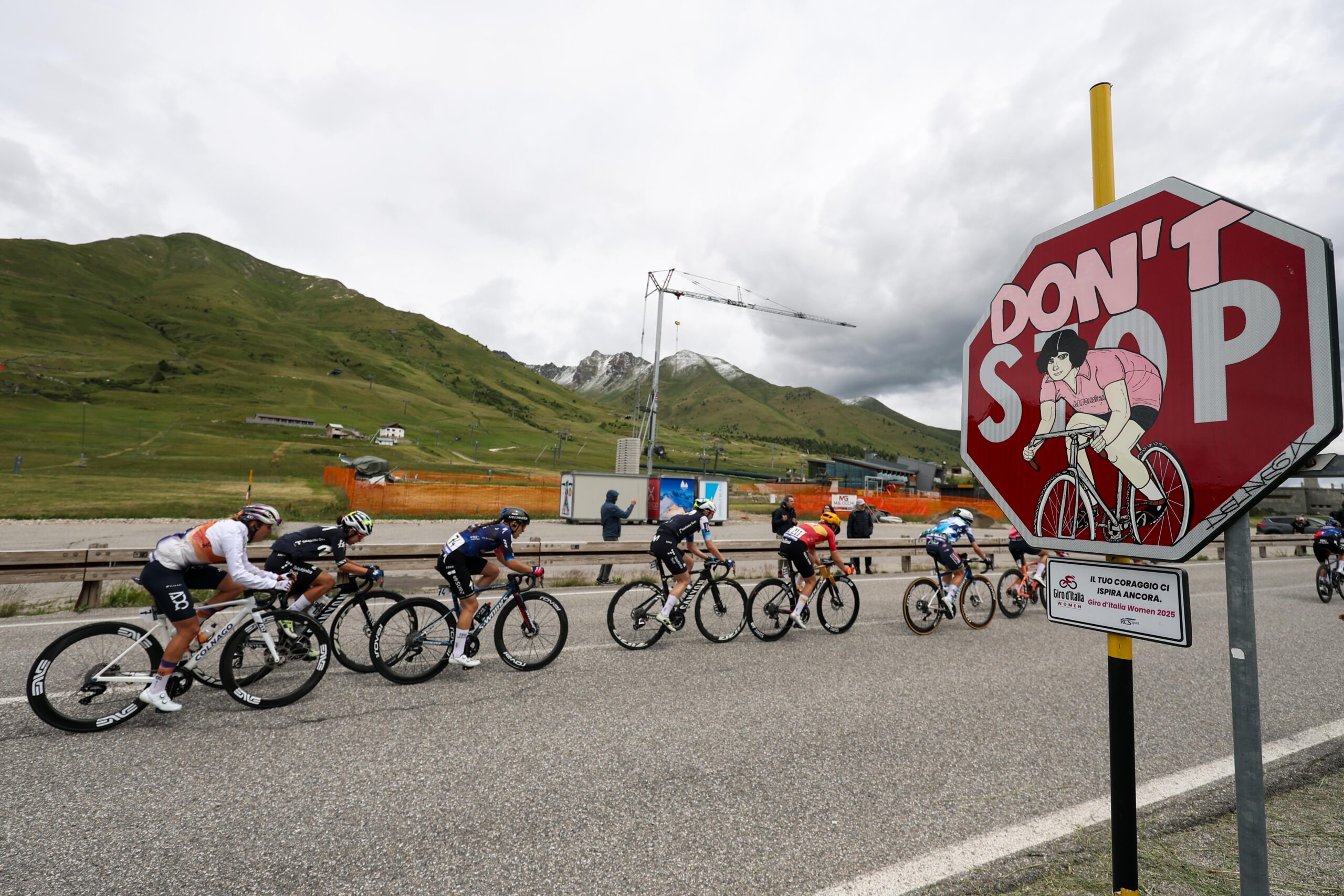
Giro d’Italia Women 2025 | Stage 3 | Best of
08/07/2025

